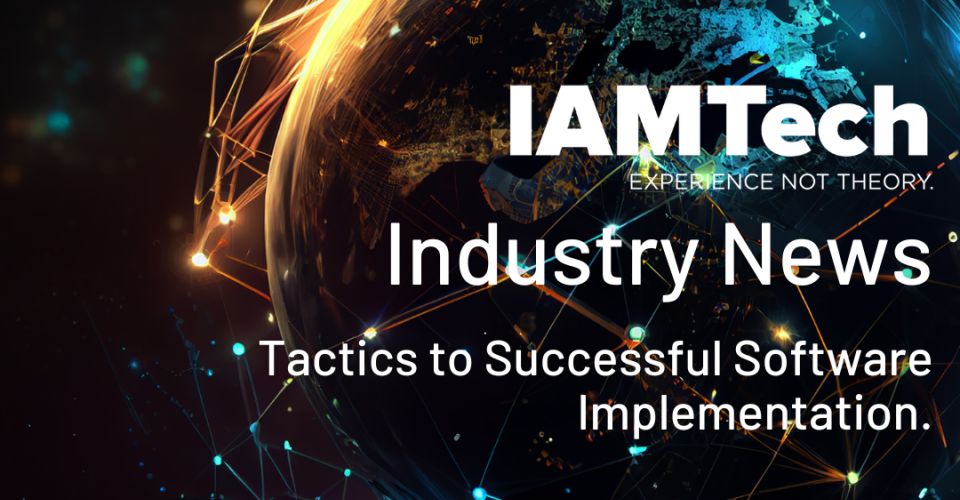
Implementing industrial software can revolutionise operations, streamline processes, and boost productivity. Yet, the journey from selecting a software solution to achieving full utilisation has many challenges. The secret ingredient to a successful implementation? While there isn’t a one-size-fits-all solution for every organisation, certain tactics can significantly enhance the likelihood of success. Drawing from over two decades of software implementation experience, IAMTech shares insights on avoiding common mistakes within the software integration process.
In our last newsletter, we emphasised the importance of stakeholder involvement, engagement, and empowerment from the outset of any software project. This week, we explore the need for a common, agreed vision coupled with strong leadership—integral components for any successful software project.
Articulating a Clear Vision
A clear vision is the cornerstone of successful software implementation.
“If you can’t articulate your vision at the beginning of every meeting within 20 seconds, it’s too complicated.”
Simplicity is key. A straightforward Vision ensures that all stakeholders are aligned and moving towards the same goal.
The vision sets the direction and defines what success looks like. It provides a common purpose that motivates and guides the project team. Without a clear vision, projects can quickly become fragmented, with different stakeholders pulling in different directions. This misalignment can lead to delays, increased costs, and ultimately, project failure.
Creating a vision requires input from all key stakeholders. Engage them early in the process to gather their insights and perspectives. This collaborative approach not only helps in crafting a comprehensive vision but also fosters a sense of ownership and commitment amongst stakeholders.
The Role of Strong Leadership
Once the vision is established, strong leadership is essential to drive it forward. Leaders play a critical role in maintaining focus, facilitating decision-making, and ensuring that the vision is translated into actionable plans.
Strong leaders are decisive, resilient, and excellent communicators. They can navigate complex challenges, manage diverse teams, and maintain momentum even in the face of setbacks. They can make tough decisions, especially when there is no clear consensus among stakeholders.
Consider a multinational energy company implementing software across all its assets worldwide. The company’s vision is to have a standardised process for Shutdowns, Turnarounds, and Outages (STOs), accepting a 10% variation for local or regional differences. This clear vision provides a solid foundation. However, without strong leadership to drive this vision, the project can falter.
For instance, when defining the "to-be" business processes, leaders must be strong enough to make decisions, even when a consensus is hard to achieve. If leaders allow endless debates without making firm decisions, the project can become delayed in indecision and conflict.
“Effective leaders view discussions as opportunities to gather diverse experiences and insights from different sites and use this information to inform their decisions and improve the projects outcome.”
Avoiding Common Pitfalls
Here are just a few common pitfalls in software implementation projects, and how to avoid them:
- Lack of a Clear Vision
A vague or overly complex vision can lead to confusion and misalignment. Ensure your vision is simple, clear, and easily communicated.
- Inadequate Leadership
Weak leadership can result in indecision and lack of direction. Invest in developing strong leaders who can drive the project forward with confidence.
- Insufficient Stakeholder Engagement
Stakeholder engagement is crucial for buy-in and successful implementation. Engage stakeholders early and regularly throughout the project.
- Resistance to Change
Change can be challenging, and resistance is common. Address resistance by communicating the benefits of the new software and providing adequate training and support.
- Overlooking Local Differences
While a standardised approach is beneficial, it’s essential to acknowledge and accommodate local or regional variations. This flexibility can enhance acceptance and usability of the software.
In Conclusion
Successful software implementation is not a matter of luck. It requires a clear vision, strong leadership, and strategic engagement of stakeholders. By articulating a simple, compelling vision and empowering leaders to drive this vision, organisations can navigate the complexities of software implementation and achieve transformative results.
At IAMTech, we are committed to helping our clients avoid the common pitfalls that can impede a successful software implementation. With over two decades of experience, we understand the challenges and more importantly know how to overcome them. Will you make your best decision today and contact us to learn more?
This newsletter has been based on ‘Secrets to a Successful STO’ a talk by Ross Coulman (MD, IAMTech) and any quotes are attributed to him.




































